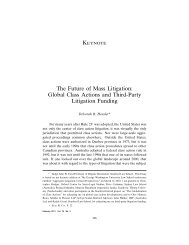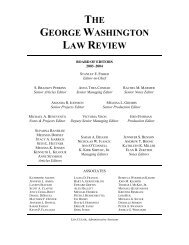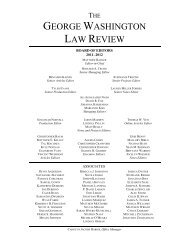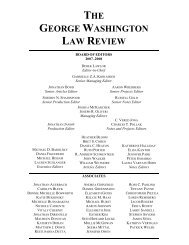View PDF - The George Washington Law Review
View PDF - The George Washington Law Review
View PDF - The George Washington Law Review
You also want an ePaper? Increase the reach of your titles
YUMPU automatically turns print PDFs into web optimized ePapers that Google loves.
COMMENTARY<br />
Stops and Frisks, Race, and the Constitution<br />
Paul J. Larkin, Jr. *<br />
ABSTRACT<br />
For more than a decade, the New York City Police Department (“NYPD”)<br />
has pursued an aggressive strategy to reduce street crime. Among the steps that<br />
the NYPD has taken is to stop and frisk anyone suspected of having committed,<br />
committing, or being about to commit a crime, such as the illegal possession of a<br />
firearm. New York City Mayor Michael Bloomberg and NYPD Police<br />
Commissioner Ray Kelly have touted the NYPD’s stop-and-frisk practice as being<br />
responsible for the reduction in crime, particularly homicides, that New York City<br />
has witnessed over the past decade. <strong>The</strong> practice is controversial, however,<br />
because the vast majority of individuals stopped are African American or<br />
Hispanic. This controversy eventually made its way into court. Nineteen parties<br />
who had been stopped by the NYPD brought suit against the City in Floyd v. City<br />
of New York. After a trial, the federal district court ruled that the NYPD’s stopand-frisk<br />
practice violated the Fourth Amendment and the Equal Protection<br />
Clause of the Fourteenth Amendment. <strong>The</strong> court, however, applied the wrong<br />
legal analysis to the plaintiffs’ Fourth Amendment claims. <strong>The</strong> court relied on a<br />
statistical analysis of the NYPD’s stop-and-frisk practice as a whole, but the<br />
Fourth Amendment requires each stop or frisk to be examined individually. By<br />
contrast, the district court may have been correct in its equal protection ruling.<br />
<strong>The</strong> court was troubled by evidence in the record that the NYPD cared only about<br />
the number of stops, not their legality, as well as evidence of bigotry. That<br />
* Senior Legal Fellow and Manager, Overcriminalization Project, <strong>The</strong> Heritage<br />
Foundation; M.P.P., <strong>The</strong> <strong>George</strong> <strong>Washington</strong> University, 2010; J.D., Stanford <strong>Law</strong> School,<br />
1980; B.A., <strong>Washington</strong> and Lee University, 1977. <strong>The</strong> views expressed in this article are<br />
the author’s own and should not be construed as representing any official position of <strong>The</strong><br />
Heritage Foundation. In the interest of full disclosure, I was counsel for the United States in<br />
two cases mentioned below: United States v. Sokolow, 490 U.S. 1 (1989), and Michigan v.<br />
Chesternut, 486 U.S. 567 (1988).<br />
September 2013 Vol. 82 Arguendo<br />
1
2 THE GEORGE WASHINGTON LAW REVIEWARGUENDO [Vol. 82<br />
evidence may be sufficient to support the court’s ruling.<br />
INTRODUCTION<br />
In August 2013, federal district court Judge Shira Scheindlin issued a<br />
195-page opinion in Floyd v. City of New York 1 holding unconstitutional<br />
the longstanding New York City Police Department (“NYPD”) stop-andfrisk<br />
practice used to question persons suspected of criminal activity. 2 <strong>The</strong><br />
NYPD has used that practice to implement the “Broken Windows” theory<br />
of policing first made famous by a 1982 article in <strong>The</strong> Atlantic, written by<br />
James Q. Wilson and <strong>George</strong> L. Kelling, entitled Broken Windows: <strong>The</strong><br />
Police and Neighborhood Safety. 3 <strong>The</strong> “Broken Windows” theory posits<br />
that aggressive police enforcement of low-level infractions deters wrongdoing<br />
and enhances community safety by arresting offenders on the cusp of<br />
committing a serious crime. 4<br />
In 1968, the U.S. Supreme Court in Terry v. Ohio 5 approved both the<br />
brief stop for questioning of a person suspected of criminal activity and the<br />
frisk of a stopped party reasonably believed to be armed and dangerous. 6<br />
<strong>The</strong> NYPD used that practice on more than 4.4 million occasions from January<br />
2004 to June 2012. 7 Troubled—as many people would be—by the<br />
fact that more than eighty percent of the parties stopped and frisked were<br />
African American or Hispanic, 8 Judge Scheindlin held that the NYPD practice<br />
violates the Fourth Amendment 9 and the Equal Protection Clause of the<br />
Fourteenth Amendment. 10<br />
Various parties have already weighed in on one side or the other of the<br />
court’s decision. So far, the parties have taken opposing sides in a “great<br />
taste, less filling” debate—the judge was clearly right or plainly wrong on<br />
both issues. 11 This Commentary advances a slightly different view: the<br />
1 Floyd v. City of New York, No. 08 Civ. 1034 (SAS), 2013 WL 4046209 (S.D.N.Y.<br />
Aug. 12, 2013).<br />
2 Id. at *7.<br />
3 See James Q. Wilson & <strong>George</strong> L. Kelling, Broken Windows: <strong>The</strong> Police and<br />
Neighborhood Safety, ATLANTIC, Mar. 1982, at 29.<br />
4 See id. at 31–34.<br />
5 Terry v. Ohio, 392 U.S. 1 (1968).<br />
6 Id. at 30–31.<br />
7 Floyd, 2013 WL 4046209, at *3.<br />
8 Id. at *1.<br />
9 U.S. CONST. amend. IV (“<strong>The</strong> right of the people to be secure in their persons,<br />
houses, papers, and effects, against unreasonable searches and seizures, shall not be violated<br />
. . . .”).<br />
10 U.S. CONST. amend. XIV, § 1 (“No State shall . . . deny to any person within its<br />
jurisdiction the equal protection of the laws.”).<br />
11 Compare, e.g., Terry Eastland, Don’t Stop Frisking, WKLY. STANDARD, Aug. 26,
2013] STOPS AND FRISKS, RACE, AND THE CONSTITUTION 3<br />
judge is likely wrong about the Fourth Amendment, but she may be right<br />
about the Equal Protection Clause, although the latter question is a close<br />
one.<br />
I. THE FOURTH AMENDMENT<br />
New York City Mayor Michael Bloomberg and NYPD Police Commissioner<br />
Ray Kelly have defended the NYPD stop-and-frisk practice by<br />
repeating the mantra that it deters crime and saves lives. 12 That defense is<br />
relevant to the plaintiffs’ Fourteenth Amendment claim that the NYPD’s<br />
stop-and-frisk practice is bigoted 13 because it supports the argument that<br />
the City intended not to discriminate, but to protect potential victims in minority<br />
communities against violent assault. But that defense is irrelevant to<br />
the plaintiffs’ Fourth Amendment claim. Arresting people on a whim or at<br />
random might also be an effective practice—in fact, the East German Stasi<br />
did just that—but today that practice would be patently illegal. <strong>The</strong> police<br />
cannot retroactively justify an unlawful search or seizure on the ground that<br />
they found evidence of a crime. 14<br />
<strong>The</strong> district court also pursued the wrong approach in determining the<br />
constitutionality of the NYPD’s stop-and-frisk practice under the Fourth<br />
Amendment. Judge Scheindlin admitted that it would be impossible for<br />
any judge to review the constitutionality of 4.4 million individual Terry<br />
stops and frisks, even by devoting a career to that task. 15 Instead, she relied<br />
2013, at 8 (same), Richard Cohen, Op-Ed., What Opponents of ‘Stop and Frisk,’ Gun Control<br />
Share, WASH. POST (Aug. 19, 2013), http://www.washingtonpost.com/opinions/richard-<br />
cohen-bloombergs-crusades-mean-more-people-will-die/2013/08/19/9a97836e-08f8-11e3-<br />
9941-6711ed662e71_story.html (concluding that the judge was wrong on both counts), and<br />
Editorial, Stop-and-Frisk Is Fair, NAT’L REV. ONLINE (Aug. 13, 2013, 4:00 PM),<br />
http://www.nationalreview.com/article/355689/stop-and-frisk-fair-editors (same), with John<br />
Cassidy, <strong>The</strong> Statistical Debate Behind the Stop-and-Frisk Verdict, NEW YORKER (Aug. 13,<br />
2013), http://www.newyorker.com/online/blogs/johncassidy/2013/08/scheindlin-stop-andfrisk-verdict-new-york-statistical-debate.html<br />
(concluding that the judge was right on both<br />
counts), and Delores Jones-Brown, Stop & Frisk Ruling: A Victory for American Values,<br />
CRIME REP. (Aug. 15, 2013, 1:10 AM), http://www.thecrimereport.org/viewpoints/2013-08-<br />
stop--frisk-ruling-a-victory-for-american-values (same).<br />
12 See, e.g., Michael R. Bloomberg, ‘Stop and Frisk’ Is Not Racial Profiling, WASH.<br />
POST, Aug. 19, 2013, at A19.<br />
13 See Floyd, 2013 WL 4046209, at *19.<br />
14 See, e.g., Wong Sun v. United States, 371 U.S. 471, 484 (1963) (noting the “essential<br />
vice” in “a proposition we have consistently rejected—that a search unlawful at its inception<br />
may be validated by what it turns up”); Byars v. United States, 273 U.S. 28, 29<br />
(1927) (“A search prosecuted in violation of the Constitution is not made lawful by what it<br />
brings to light . . . .”).<br />
15 Floyd, 2013 WL 4046209, at *4, *16.
4 THE GEORGE WASHINGTON LAW REVIEWARGUENDO [Vol. 82<br />
heavily on a statistical analysis of that practice. 16 But it is a mistake to decide<br />
the constitutionality of Terry stops based on statistics. Stops are not<br />
like vitamins; each one differs from the other. Pharmaceutical firms conduct<br />
quality control by inspecting a sample of each batch of drugs because,<br />
if the manufacturing process is working properly, each batch and each drug<br />
should be the same as the others. That is not true for Terry stops, in which<br />
the facts of each stop are distinct from one another and each stop must be<br />
independently examined. 17 True, the district court analyzed a sample of<br />
nineteen stop-and-frisk cases, 18 but it is not obvious that those cases, chosen<br />
by plaintiffs’ counsel, are a representative sample. That is like evaluating<br />
the fairness of the entire New York City criminal trial process by analyzing<br />
nineteen trials chosen by defendants.<br />
Judge Scheindlin was troubled by the NYPD’s reports indicating that<br />
roughly 200,000 (at least) of the 4.4 million Terry stops, or about five percent,<br />
were unjustified. 19 Apparently, she believed that a ninety-five percent<br />
success rate meant that the NYPD had often violated the Fourth Amendment.<br />
As noted, however, that wholesale-level approach is mistaken because<br />
each case must be individually reviewed. What is more, if it were<br />
appropriate to use wholesale-level percentages to decide whether the<br />
NYPD regularly has acted lawfully, a ninety-five percent success rate<br />
should prove that it has not. <strong>The</strong> law does not require certainty that crime<br />
is afoot before a police officer can make a Terry stop, nor does the law demand<br />
that an officer know that it is more likely than not that crime is afoot.<br />
A police officer needs only “reasonable suspicion,” and that standard of<br />
proof is even less demanding than the “probable cause” standard necessary<br />
16 See id. at *15–20.<br />
17 See, e.g., United States v. Arvizu, 534 U.S. 266, 273 (2002) (“When discussing<br />
how reviewing courts should make reasonable-suspicion determinations, we have said repeatedly<br />
that they must look at the totality of the circumstances of each case to see whether<br />
the detaining officer has a particularized and objective basis for suspecting legal wrongdoing.”<br />
(internal quotation marks omitted)); Florida v. Bostick, 501 U.S. 429, 437 (1991)<br />
(“[T]he crucial test [for deciding if a person has been “seized”] is whether, taking into account<br />
all of the circumstances surrounding the encounter, the police conduct would have<br />
communicated to a reasonable person that he was not at liberty to ignore the police presence<br />
and go about his business.” (internal quotation marks omitted)); United States v. Mendenhall,<br />
446 U.S. 544, 554 (1980) (“[A] person has been ‘seized’ within the meaning of the<br />
Fourth Amendment only if, in view of all of the circumstances surrounding the incident, a<br />
reasonable person would have believed that he was not free to leave . . . .”); cf. City of Los<br />
Angeles v. Lyons, 461 U.S. 95, 108 (1983) (“We cannot agree that the odds that Lyons<br />
would not only again be stopped for a traffic violation but would also be subjected to a<br />
chokehold without any provocation whatsoever are sufficient to make out a federal case for<br />
equitable relief.” (citation omitted) (internal quotation marks omitted)).<br />
18 See Floyd, 2013 WL 4046209, at *2, *47.<br />
19 See id. at *4, *16, *18, *71.
2013] STOPS AND FRISKS, RACE, AND THE CONSTITUTION 5<br />
to make an arrest. 20 In other words, by not demanding certainty that someone<br />
is involved in criminal activity, the Fourth Amendment allows the police<br />
to make mistakes. What is more, by requiring only reasonable suspicion<br />
that a person may be involved in a crime, the Terry standard contemplates<br />
that the police often will be wrong. Accordingly, proof that the<br />
NYPD has been justified ninety-five percent of the time is laudable. Why?<br />
Because if macro-level numbers count, that level of success approaches<br />
what we would expect if the police had to operate under the “beyond a reasonable<br />
doubt” standard necessary for conviction.<br />
As a result of those errors, Judge Scheindlin conflated two different<br />
inquiries: (1) did the NYPD commit a massive number of unlawful stops<br />
and frisks, and, if so, (2) was that number sufficiently large that New York<br />
City can be held liable for having encouraged or endorsed it as municipal<br />
policy? 21 Statistical evidence cannot substitute for the case-by-case analysis<br />
necessary to answer the first question because the Fourth Amendment<br />
only outlaws unlawful individual searches and seizures, not search and seizure<br />
policies. In 1968, the Supreme Court, in Sibron v. New York, 22 declined<br />
to review the facial constitutionality of the then-existing New York<br />
stop-and-frisk statute on the ground that the issue should be addressed in a<br />
particular factual scenario. In the Court’s words:<br />
<strong>The</strong> parties on both sides of these two cases have urged that the<br />
principal issue before us is the constitutionality of [the New York<br />
statute] “on its face.” We decline, however, to be drawn into what<br />
we view as the abstract and unproductive exercise of laying the<br />
extraordinarily elastic categories of [the New York statute] next to<br />
the categories of the Fourth Amendment in an effort to determine<br />
whether the two are in some sense compatible. <strong>The</strong> constitutional<br />
validity of a warrantless search is pre-eminently the sort of ques-<br />
20 See, e.g., Illinois v. Wardlow, 528 U.S. 119, 123 (2000) (“‘[R]easonable suspicion’<br />
is a less demanding standard than probable cause and requires a showing considerably less<br />
than preponderance of the evidence . . . .”); United States v. Sokolow, 490 U.S. 1, 7 (1989).<br />
21 See Floyd, 2013 WL 4046209, at *2, *70–72 (“This case is also not primarily about<br />
the nineteen individual stops that were the subject of testimony at trial. Rather, this case is<br />
about whether the City has a policy or custom of violating the Constitution by making unlawful<br />
stops and conducting unlawful frisks.” (footnote omitted) (citing Monell v. New<br />
York City Dep’t of Soc. Servs., 436 U.S. 658 (1978))); see also, e.g., Connick v. Thompson,<br />
131 S. Ct. 1350, 1359 (2011) (“Plaintiffs who seek to impose liability on local governments<br />
under § 1983 must prove that action pursuant to official municipal policy caused their injury.<br />
Official municipal policy includes the decisions of a government’s lawmakers, the acts<br />
of its policymaking officials, and practices so persistent and widespread as to practically<br />
have the force of law.” (citation omitted) (internal quotation marks omitted)).<br />
22 Sibron v. New York, 392 U.S. 40 (1968).
6 THE GEORGE WASHINGTON LAW REVIEWARGUENDO [Vol. 82<br />
tion which can only be decided in the concrete factual context of<br />
the individual case. 23<br />
Judge Scheindlin never explained why Floyd differs from Sibron. If<br />
there were a large number of unlawful stops and frisks, that number could<br />
justify the inference that New York City had a policy of encouraging unlawful<br />
police practices, but the answer to the latter inquiry is secondary to,<br />
and hinges on, the answer to the former.<br />
II.<br />
THE EQUAL PROTECTION CLAUSE<br />
<strong>The</strong> court’s discussion of the Fourth Amendment may turn out to be of<br />
little importance. <strong>The</strong> nonstatistical evidence on which Judge Scheindlin<br />
relied—e.g., the gross number of stops of blacks and Hispanics, the pressure<br />
from NYPD commanders to increase the number of stops, the NYPD’s<br />
indifference to the legality of those stops and frisks, and evidence of what<br />
the judge termed “indirect racial profiling” 24 —may support the inference<br />
that the City violated the Equal Protection Clause regardless of whether the<br />
NYPD stop-and-frisk practice violates the Fourth Amendment. <strong>The</strong> two<br />
inquiries are distinct. <strong>The</strong> latter requires examination of the facts and circumstances<br />
of each separate stop and frisk, 25 whereas the former asks<br />
whether senior NYPD or City officials adopted a stop-and-frisk policy<br />
based on impermissible racial criteria and encouraged police officers to<br />
rely on it when confronting people on the street. 26<br />
A government practice can violate the Equal Protection Clause if it<br />
discriminates because of an immutable characteristic, such as race, or if it<br />
is the product of discriminatory animus. 27 By contrast, a facially neutral,<br />
benignly intended, and evenhandedly applied practice is not unconstitutional<br />
even if it has a disparate impact on a minority group. Proof that the<br />
decisionmaker acted, at least in part, to achieve that result is necessary. 28<br />
23 Id. at 59; see also Nicholas Quinn Rosenkranz, <strong>The</strong> Objects of the Constitution, 63<br />
STAN. L. REV. 1005, 1036 (2011) (“Congress cannot violate this clause by authorizing a<br />
search; only the President can violate it, and only by executing a search.”).<br />
24 See Floyd, 2013 WL 4046209, at *24–25, *30, *34–36, *42, *72.<br />
25 See supra text accompanying notes 17, 22–23.<br />
26 See infra text accompanying notes 28–30.<br />
27 See, e.g., Adarand Constructors, Inc. v. Pena, 515 U.S. 200, 237–39 (1995) (subjecting<br />
a facially discriminatory federal statute to strict scrutiny and remanding for application<br />
of that test); Hunter v. Underwood, 471 U.S. 222, 233 (1985) (holding unconstitutional<br />
a facially neutral state constitutional provision enacted for a racially discriminatory purpose).<br />
28 See, e.g., United States v. Armstrong, 517 U.S. 456, 463–67 (1996); McCleskey v.<br />
Kemp, 481 U.S. 279, 292–93 (1987); Pers. Adm’r v. Feeney, 442 U.S. 256, 279 (1979);<br />
Village of Arlington Heights v. Metro. Hous. Dev. Corp., 429 U.S. 252, 266 (1977); Wash-
2013] STOPS AND FRISKS, RACE, AND THE CONSTITUTION 7<br />
Moreover, the necessary discriminatory purpose implies more than “volition”<br />
or “awareness of consequences”—a state of mind often called “general<br />
intent.” 29 Instead, a challenger must prove that the decisionmaker acted<br />
with the “specific intent” to discriminate. A party challenging the application<br />
of a facially race-neutral policy must prove that the decisionmaker<br />
“selected or reaffirmed a particular course of action at least in part ‘because<br />
of,’ not merely ‘in spite of,’ its adverse effects upon an identifiable<br />
group.” 30<br />
What is quite damaging to the City’s case are three types of evidence<br />
that Judge Scheindlin described in detail: (1) NYPD commanders demanded<br />
that patrol officers satisfy an implicit quota of stops per month; 31 (2) the<br />
NYPD did not seriously review those stops to determine if they were valid;<br />
32 and (3) the NYPD may have relied on macro-level racial numbers<br />
(e.g., ninety percent of armed robberies in a particular neighborhood involve<br />
black offenders) as a basis for making micro-level stops and frisks<br />
(e.g., this black person is likely to be an armed robber). 33 That evidence<br />
impeaches the City’s defense that NYPD officers rely on specific and objective<br />
evidence of guilt, because it suggests that the City only cared about<br />
the number of stops, not the number of lawful stops. 34 As Judge Scheindlin<br />
put it, “[f]or the purposes of performance review, an unconstitutional stop<br />
is no less valuable to an officer’s career than a constitutional one—because<br />
the two are indistinguishable.” 35<br />
Judge Scheindlin found one piece of evidence particularly disturbing.<br />
At a meeting with former New York Governor David Patterson and a few<br />
senior state legislators, NYPD Commissioner Kelly said that “he focused<br />
on young blacks and Hispanics because he wanted to instill fear in them,<br />
every time they leave their home, they could be stopped by the police.” 36<br />
ington v. Davis, 426 U.S. 229, 242 (1976).<br />
29 Feeney, 442 U.S. at 279; see also United States v. Bailey, 444 U.S. 394, 403 (1980)<br />
(noting that the “venerable distinction” between general and specific intent has caused “a<br />
good deal of confusion”); WAYNE R. LAFAVE, CRIMINAL LAW § 5.2(e) (5th ed. 2010) (discussing<br />
the many different meanings of “general intent” in criminal law).<br />
30 Feeney, 442 U.S. at 279; see also, e.g., Armstrong, 517 U.S. at 463–67; McCleskey,<br />
481 U.S. at 292–93; Village of Arlington Heights, 429 U.S. at 266; <strong>Washington</strong>, 426 U.S. at<br />
242.<br />
31 See Floyd v. City of New York, No. 08 Civ. 1034 (SAS), 2013 WL 4046209, at<br />
*20–21, *26–33 (S.D.N.Y. Aug. 12, 2013).<br />
32 See id. at *24–25, *26–27, *33, *37–40, *42–47.<br />
33 See id. at *20–21.<br />
34 See id. at *33 (“In contrast to this detailed review for effectiveness, there is no process<br />
for evaluating whether enforcement activities are legally justified.”); id. at *37–40.<br />
35 Id. at *33.<br />
36 Id. at *36 (internal quotation marks omitted).
8 THE GEORGE WASHINGTON LAW REVIEWARGUENDO [Vol. 82<br />
Judge Scheindlin believed that Kelly’s statement reflected racial animus. 37<br />
She also found significant the City’s failure to have Kelly testify at trial in<br />
order to offer a benign explanation for that remark. 38 That tactical decision,<br />
which the City may now regret, allowed the judge to draw an adverse inference<br />
that Kelly’s testimony would have been unfavorable. 39 Those two<br />
factors, atop the other evidence in the case, persuaded her that the City had<br />
acted with impermissible racial animus. 40<br />
If a senior New York City official tacitly adopted and directed the<br />
NYPD to pursue a racially tainted stop-and-frisk policy, then, given the<br />
large number of blacks and Hispanics stopped, it would be reasonable to<br />
conclude that impermissible racial considerations affected patrol officers’<br />
decisions to conduct a stop and frisk in a nontrivial number of cases. <strong>The</strong><br />
appropriate remedy would be to forbid reliance on any such policy, to discipline<br />
the appropriate city officials—within or outside of the NYPD—who<br />
adopted that policy or encouraged it to be used, and to oversee for a limited<br />
period of time how the NYPD responds. <strong>The</strong>re would be no need to analyze<br />
the constitutionality of each police-citizen encounter under the Fourth<br />
Amendment in order to provide relief to the plaintiffs.<br />
III. RACE AND LAW ENFORCEMENT<br />
When the government can use race as a legitimate criterion in law enforcement<br />
decisionmaking is a tricky issue. It is clear, however, that there<br />
are times when the government may do so. For example, the government<br />
can use an undercover African American police officer, instead of a Son of<br />
the Old Sod, when trying to infiltrate a Jamaican drug posse. <strong>The</strong> converse<br />
is true when investigating the Irish Republican Army. Few would disagree<br />
with those propositions. <strong>The</strong> difficulty arises when the government uses<br />
race, not as a basis for selecting law enforcement officers for specialized<br />
tasks, but when selecting members of the public for coercive scrutiny.<br />
Floyd raises the question of what role, if any, race can play in making<br />
the decision to stop or frisk a person. Sometimes it may. Race can be used<br />
as one of several identifying factors in deciding whether reasonable suspicion<br />
exists to believe that a particular individual has committed, is committing,<br />
or is about to commit a crime. 41 On one end of the spectrum, the Fed-<br />
37 See id.<br />
38 Id. at *73.<br />
39 See, e.g., Interstate Circuit, Inc. v. United States, 306 U.S. 208, 225–26 (1939)<br />
(holding that the trier of fact may draw an adverse inference from a party’s failure to present<br />
testimony from a relevant witness).<br />
40 Floyd, 2013 WL 4046209, at *5, *24.<br />
41 See, e.g., Brown v. City of Oneonta, 221 F.3d 329, 337–38 (2d Cir. 2000) (“In act-
2013] STOPS AND FRISKS, RACE, AND THE CONSTITUTION 9<br />
eral <strong>Law</strong> Enforcement Training Center (“FLETC”) teaches federal agents<br />
to use the mnemonic device, “Some Robbers Are Happy When Caught,” to<br />
remember what factors should be used in order to identify a suspect: sex,<br />
race, age, height, weight, and color of hair and eyes. 42 An eyewitness who<br />
supplies all of those facts has provided a useful description of a robbery<br />
suspect. <strong>The</strong> police need not ignore the race of a suspect when it is included<br />
in that report. 43 At the other end of the spectrum is the scenario in<br />
which the only fact that a witness provides is the suspect’s race. <strong>The</strong> police<br />
may keep an eye out for suspects of that race who act in an incriminating<br />
manner, but the police cannot use that fact alone as a basis for stopping<br />
every black male and female in the vicinity. 44 That comes too close for<br />
comfort to the forbidden and ignorant syllogism that “All blacks are criminals.<br />
John Doe is black. Accordingly, John Doe is a criminal.” That chain<br />
of reasoning is wrong and impermissible from the very first step. <strong>The</strong> facts<br />
in Floyd fall between those two bookends of the legitimate and illegitimate<br />
considerations of race. <strong>The</strong> question in Floyd then is whether those facts<br />
are sufficiently close to the illegitimate end of the spectrum to offend the<br />
Equal Protection Clause.<br />
CONCLUSION<br />
<strong>The</strong> City has appealed the district court’s decision, 45 so the controversy<br />
over the NYPD’s stop-and-frisk practice will not end anytime soon. But it<br />
may well be that the parties or the courts will refocus the discussion away<br />
from the question of whether the NYPD’s individual stops and frisks were<br />
lawful and instead toward whether the City had a policy of relying entirely<br />
or too heavily on race as a basis for its stop-and-frisk practice. <strong>The</strong> Second<br />
Circuit, and perhaps the Supreme Court, will weigh in as a matter of constitutional<br />
law. If the NYPD’s stop-and-frisk practice does not violate the<br />
U.S. Constitution, it will then be up to elected and appointed officials—<br />
ing on the description provided by the victim of the assault—a description that included race<br />
as one of several elements—defendants did not engage in a suspect racial classification that<br />
would draw strict scrutiny.”).<br />
42 FLETC taught that mnemonic device when the author attended the academy in<br />
1998 as part of FLETC’s Criminal Investigator Training Program (CITP-810).<br />
43 See Brown, 221 F.3d at 337–39.<br />
44 See, e.g., United States v. Avery, 137 F.3d 343, 355 (6th Cir. 1997) (“If law enforcement<br />
adopts a policy, employs a practice, or . . . takes steps to initiate an investigation<br />
of a citizen based solely upon that citizen’s race, without more, then a violation of the Equal<br />
Protection Clause has occurred.”).<br />
45 Joseph Ax, NYC Appeals Ruling That NYPD’s Stop-and-Frisk Policy Is Unlawful,<br />
REUTERS (Aug. 16, 2013, 3:09 PM), http://www.reuters.com/article/2013/08/16/us-usanewyork-police-appeal-idUSBRE97F0XA20130816.
10 THE GEORGE WASHINGTON LAW REVIEWARGUENDO [Vol. 82<br />
and, ultimately, to the public—to decide where to draw the line as a matter<br />
of policy.









